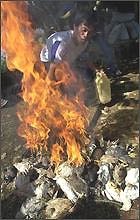
July 22, 2005 Jakarta, Indonesia – The World Health Organization (WHO) confirmed this week: “The Ministry of Health in Indonesia reported that a 38-year-old father who died on 12 July was the country’s first laboratory-confirmed H5N1 positive human case of avian influenza. His two daughters also died of severe pneumonia illness compatible with H5N1 infection, but laboratory confirmation is not yet available. Limited samples were available from the 8-year-old daughter who died on 14 July, and the 1-year-old daughter who died on 9 July.”
H5N1 Virus Found in Frozen Duck Meat from China
The journal Virology and WHO also confirm H5N1 bird flu virus was found in processed frozen duck meat shipped from China to Japan in 2003. This is not the first time the deadly virus has been found in processed meat. The implication from this new study is that the deadly virus was in China birds when the ducks were processed.
“This is an indicator that H5N1 viruses are widespread in Asia in many different kinds of fowl,” said WHO’s Western Pacific Region spokesman, Bob Dietz. A Hong Kong scientist also reports that the 1,000 geese that died in Qinghai province this year apparently contracted the H5N1 virus from poultry.
In the past two years, 57 people in Vietnam, Thailand, Cambodia and Indonesia have died from the H5N1 avian flu virus. As the cases rise in Southeast Asia, virologists and other medical experts worry that the lethal virus will mutate to transmit more efficiently from human-to-human. If that happens, the next world pandemic might be upon us.
More Lethal H5N1 Bird Flu Strain in China?
This week, the Proceedings of the National Academy of Science reported that the virus circulating in some of the bird population is becoming less lethal to birds. That creates another problem: more and larger virus pool in more surviving chickens, ducks, geese and other birds. That means that more migrating birds could carry the virus outside Southeast Asia.
However, in China the Wenhuibao newspaper and World Health Organization reported in June that the H5N1 virus in migratory birds there might be more lethal than previous strains. Chinese scientists reported in the journal, Science, that gene sequencing from some of the 6,000 birds that have died of bird blue in Qinghai province indicated those bird flu strains were more lethal than strains in previous outbreaks. Gao Fu, Director of the Chinese Academy of Science’s Microbiology Research Institute reports: “The results show that this new strain of H5N1 is very harmful. The deadliness of the virus far exceeds that of the virus strains previously found in water fowl in northern China.”
In the China lab tests, the H5N1 viral strain under study killed chickens within 20 hours and mice within three days. WHO spokesman, Roy Wadia, said, “It would seem to indicate what we’ve known all along, that this is a highly pathogenic strain that has killed many wild birds, so it’s not surprising that it would kill mice.”
Websites:
W.H.O. Bird Flu Indonesia: http://www.who.int/csr/don/2005_07_21a/en/index.html
© 1998 - 2024 by Linda Moulton Howe.
All Rights Reserved.

